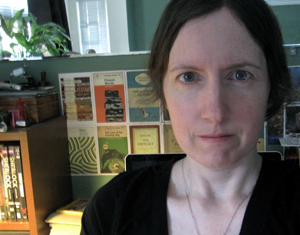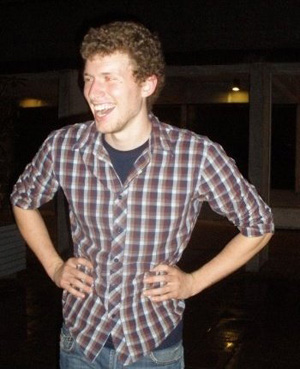Like a Coat or a Bicycle or a Lens: Stefan Krecsy in Conversation with Kim Trainor

Malahat volunteer Stefan Krecsy talks with 2013 Long Poem Prize-winner, Kim Trainor about her winning poem, "Nothing is Lost."
You open your long poem, “Nothing is Lost,” with an extensive excerpt from Elaine Scarry’s The Body in Pain: The Making and Unmaking of the World and throughout your work you freely integrate and adapt this passage. While you clearly wanted the reader to have this text in mind throughout “Nothing is Lost,” why did you want to respond to this passage in particular and did you set out writing with the passage in mind, or did you incorporate it later?
I wrote an earlier version of the poem a year or so ago but it was too dark. When I came back to it again this past fall, what made it work for me the second time was having reread Elaine Scarry's book The Body in Pain, which has been an important book to me over the years for thinking about artefacts and about language itself as artefact, and their role in making the world, as a counter to its unmaking, its destruction. I could have chosen many passages, but this one in particular places emphasis on the transformative effects of objects in human lives, which is linked to the poem's exploration of objects found in the mass graves of the Srebrenica genocide. Those precise objects documented in the Books of Belongings (there are several such books) have importance to the families who are searching for their loved ones; the objects also have a transformative effect I think on those of us who are not personally affected by this genocide, but become aware of their existence. Although I didn't intend to, I began to incorporate fragments from Scarry's work and from the ICRC (International Red Cross) press release from the very first stanza.
Along with Scarry’s work, you quote the International Red Cross’s news release on the “Book of Belongings” as a sort of prologue or extended epigraph. I see these two excerpts working to highlight some of the philosophical and political influences of your poem, and I’m curious if you could touch on some of your poetic influences as well?
A significant poetic influence was Carolyn Forché's "On Earth" in Blue Hour, and her work in general, espeically The Angel of History. "On Earth" is in abecedarian form, but in a much longer, more attenuated form. There are allusions in the poem to other influences here and there -- Akhmatova, Radnóti, Owen, Donne.
I discovered a passage on your blog where you write that you “want to insist upon a connection between lyric I and poet, however mediated it may be” as well as the value of documentary poetry. I felt a great deal of resonance between this post and “Nothing is Lost,” and though this may be a tall task, would you be willing to elaborate for our readers why you are so drawn to this experiential sort of poetry?
I think what drew me to poetry when I first began to write it was its ethical component -- that it has work to do in the world, the work of paying attention, of bringing events and objects and human subjects to the attention of others. I like the idea of a poem as an artefact that goes out into the world like a coat or a bicycle or a lens that helps us to transform the material world and influences our interactions with others. I'm sure I'm being much too serious about this, but it's how I feel at the moment.
To me, your poem seeks to reflect on “a loss that cannot be recorded in many pages” and seeks to do so primarily through fragments, an approach that is readily apparent throughout the G stanza where you write: “gained and nothing is lost / gesture of a hand in conversation / glint of tools at dusk / glove with traces of dirt, spores, clay, blood.” At the risk of being oxymoronic, could you expand on your decision to focus on fragmentary lines and images to capture loss?
The Book of Belongings is a book of fragments, of the remnants of belongings and of lives. The massacre sites in Srebrenica were initially tampered with in an attempt to cover up the genocide, so the human remains were often themselves fragmented, which is why it has been so difficult to identify the missing. As of last year they had identified 90% of those who were missing -- 17 years later. It seemed right that the poem would then resist any kind of totality or explanatory narrative. The fragments pull against the desire we have for explanation and consolation, when there may be none.
In the context of this poem, the line “I was this one and no other / identity card with name and photograph and number” struck me as particularly powerful image. You seem particularly focused on traces, including the trace elements of the human body, i.e., “molybdenum fluorine chlorine iodine.” Why is that?
I was thinking especially of DNA traces. We live in a time when we've had to create an International Commission on Missing Persons to do DNA testing to identify the exhumed remains of victims of genocide. I came across a newspaper article just last week on a Stalinist mass grave from the 50s being excavated now in Warsaw, where they are trying to find, amongst others, the remains of Witold Pilecki, a Polish resistance fighter who infiltrated Auschwitz in order to testify to its existence. There are genocides happening today.
I would be remiss not to bring up the formal elements of your poem, and your novel use of the alphabet. What drew you to this form, and what did you feel this form allowed you to capture or accomplish in a manner that other, more conventional, forms may not have allowed?
As I mentioned, although I liked Carolyn Forché's "On Earth," which is in abecedarian form, it is somewhat attenuated -- 30 or 40 lines for example dedicated to a single letter of the alphabet, and I wanted a more concentrated form. I decided to use Psalm 119 as a model. It's an abecedarian psalm of 22 stanzas, one stanza for each letter of the Hebrew alphabet, each stanza consisting of 8 lines and every line beginning with that same letter; the psalm has other internal structural elements -- almost every line makes reference to the Torah, often using synonyms for this; there tends to be an architectural shape for each stanza.
I created my own rules -- that the lines within each stanza in my own poem should be alphabetized, that each stanza would name one belonging, and that that belonging would begin with the appropriate letter of the alphabet; that there would be some reference to memory and its various inscriptions (although I didn't always manage this) -- writing, language, grammar, DNA, the texture of the belongings themselves, all of these carry memory, carry sentience. I confess I broke my own rules where necessary. The letter “Y” went its own way. For the letter “X” I went by sound not spelling (why include xylophone under “X” and not “exhaustion” or “exist” which sound right?).
What did I like about the form? It resists narration. It resists any simple explanation of the Srebrenica genocide. It allowed for a focus on the particularity of objects. It allowed me to work by sound as much as by image: each stanza like a chord, so that individual lines could be made to resonate with one another, and then also for individual lines to repeat like a note that returns again and again; this mimics the compulsion of memory perhaps, and of lament. I thought it worked well with the Book of Belongings itself. The poem for me functions as a series of annotations in the margins of that book.

Stefan Krecsy
* * * * * * * *
Read guidelines for the 2015 Long Poem Prize here.









